Effective Position Control for a Three-Phase Motor
Abstract
:1. Introduction
2. Three-Phase Motor Position Proportional Derivative Controller Design
2.1. Induction Motor Dynamics
2.2. Permanent Magnet Synchronous Motor Dynamics
2.3. Position Proportional Derivative with a Feed-Forward Controller Design
2.4. Current Proportional Integral Controllers Design
2.5. Estability Demonstration of PD Position and PI Current Controlled Systems
3. Simulation and Experimental Results
3.1. Tests Benchees
3.1.1. IM Tests Bench
- P, rated active power, 7.5 kW;
- V, rated stator voltage, 380 V;
- Te, rated electromagnetic torque, 50 N·m;
- n, rated mechanical rotor speed, 1445 rpm (151.32 rad/s);
- Rs, stator resistance, 0.729 Ω;
- Rr, rotor resistance, 0.40 Ω;
- Lm, magnetizing inductance, 0.1125 H;
- Ls, stator inductance, 0.1138 H;
- Lr, rotor inductance, 0.1152 H;
- σ, coefficient of magnetic dispersion, 0.0346 (dimensionless);
- p, number of poles, 4;
- J, moment of inertia, 0.0503 kg·m2;
- Bv, viscous friction coefficient, 0.0105 N·m/(rad/s);
- Is, rated stator current, 15.24 A;
- Isq, rated torque current, 20 A;
- Isd, rated rotor flux current, 8.026 A;
- Ψr, rated rotor flux, 0.9030 Wb.
3.1.2. PMSM Tests Bench
- P, rated active power, 3.83 kW;
- V, rated stator voltage, 400 V;
- Te, rated electromagnetic torque, 12.2 N·m;
- n, rated mechanical rotor speed, 3000 rpm (314.16 rad/s);
- Rs, stator resistance, 0.49 Ω;
- Lsd, stator d inductance, 0.0039 H;
- Lsq, stator q inductance, 0.0069 H;
- p, number of poles, 6;
- J, moment of inertia, 0.0055 kg·m2;
- Bv, viscous friction coefficient, 0.014 N·m/(rad/s);
- Is, rated stator current, 7.62 A;
- ΨM, rotor magnets flux, 0.3556 Wb.
3.2. D1 and D2 Position and Currents Regulators Design
3.3. Simulation and Experimental Results
4. Conclusions
Author Contributions
Funding
Acknowledgments
Conflicts of Interest
References
- Vas, P. The Space-Vector method. In Electrical Machines and Drives: a Space-Vector theory approach, 1st ed.; Oxford University Press: Oxford, UK, 1992; Volume 1, pp. 32–125. [Google Scholar]
- Kume, T.; Iwakane, T. High-Performance Vector-Controlled AC Motor Drives: Applications and New Technologies. IEEE Trans. Ind. Appl. 1987, 23, 872–880. [Google Scholar] [CrossRef]
- Stojic, M.; Vukosavic, S. Design of microprocessor-based system for positioning servomechanism with induction motor. IEEE Trans. Ind. Electron. 1991, 38, 369–378. [Google Scholar] [CrossRef]
- Alkorta, P.; Barambones, O.; Cortajarena, J.A.; Vicandi, F.J.; Martija, I. Effective Proportional Derivative Position control of Induction Motor Drives. In Proceedings of the 2016 IEEE International Conference on Industrial Technology (ICIT), Taipei, Taiwan, 14–17 March 2016. [Google Scholar]
- Huang, T.; El-Sharkawi, M. High performance speed and position tracking of induction motors using multi-layer fuzzy control. IEEE Trans. Energy Convers. 1996, 11, 353–358. [Google Scholar] [CrossRef]
- Cecati, C. Position Control of the Induction Motor using a Passivity-based Controller. IEEE Trans. Ind. Appl. 2000, 36, 1277–1284. [Google Scholar] [CrossRef]
- Rodriguez, P.; Dumur, D. Generalized predictive control robustification under frequency and time-domain constraints. IEEE Trans. Control. Syst. Technol. 2005, 13, 577–587. [Google Scholar] [CrossRef]
- Veselić, B.; Peruničić-Draženović, B.; Milosavljevic, Č. High-Performance Position Control of Induction Motor Using Discrete-Time Sliding-Mode Control. IEEE Trans. Ind. Electron. 2008, 55, 3809–3817. [Google Scholar]
- Barambones, O.; Alkorta, P.; De Durana, J.M.G. A real-time estimation and control scheme for induction motors based on sliding mode theory. J. Frankl. Inst. 2014, 351, 4251–4270. [Google Scholar] [CrossRef]
- Callegaro, A.D.; Nalakath, S.; Srivatchan, L.N.; Luedtke, D.; Preindl, M. Optimization-Based Position Sensorless Control for Induction Machines. In Proceedings of the 2018 IEEE Transportation Electrification Conference and Expo (ITEC), Long Beach, CA, USA, 13–15 June 2018; pp. 460–466. [Google Scholar]
- Egiguren, P.A.; Echeverria, J.A.C.; Caramazana, O.B.; Lopez, I.M.; Alcorta, J.C. Poles Placement Position Control of Induction Motor Drives. In Proceedings of the IECON 2019—45th Annual Conference of the IEEE Industrial Electronics Society, Lisbon, Portugal, 14–17 October 2019. [Google Scholar]
- Ogasawara, S.; Akagi, H. Implementation and position control performance of a position-sensorless IPM motor drive system based on magnetic saliency. IEEE Trans. Ind. Appl. 1998, 34, 806–812. [Google Scholar] [CrossRef] [Green Version]
- Hua, Y.; Sumner, M.; Asher, G.; Gao, Q.; Saleh, K. Improved sensorless control of a Permanent Magnet Synchronous Machine using fundamental Pulse Width Modulation excitation. IET Electr. Power Appl. 2011, 5, 259–370. [Google Scholar] [CrossRef] [Green Version]
- Ghafari-Kashani, A.; Faiz, J.; Yazdanpanah, M. Integration of non-linear H∞∞ and sliding mode control techniques for motion control of a permanent magnet synchronous motor. IET Electr. Power Appl. 2010, 4, 267. [Google Scholar] [CrossRef]
- Yin, Z.; Gong, L.; Du, C.; Liu, J.; Zhong, Y. Integrated Position and Speed Loops Under Sliding-Mode Control Optimized by Differential Evolution Algorithm for PMSM Drives. IEEE Trans. Power Electron. 2019, 34, 8994–9005. [Google Scholar] [CrossRef]
- Lin, F.-J.; Lin, C.-H. A Permanent-Magnet Synchronous Motor Servo Drive Using Self-Constructing Fuzzy Neural Network Controller. IEEE Trans. Energy Convers. 2004, 19, 66–72. [Google Scholar] [CrossRef]
- Lin, F.-J.; Sun, I.-F.; Chang, J.-K.; Yang, K.-J. Intelligent position control of permanent magnet synchronous motor using recurrent fuzzy neural cerebellar model articulation network. IET Electr. Power Appl. 2015, 9, 248–264. [Google Scholar] [CrossRef]
- Yu, J.; Shi, P.; Yu, H.; Chen, B.; Lin, C. Approximation–based Discrete-time Adaptive Position Tracking Control for Interior Permanent Magnet Synchronous Motors. IEEE Trans. Cybernetics. 2015, 45, 1363–1371. [Google Scholar] [CrossRef] [PubMed]
- Belda, K.; Vosmik, D. Explicit Generalized Predictive Control of Speed and Position of PMSM Drives. IEEE Trans. Ind. Electron. 2016, 63, 3889–3896. [Google Scholar] [CrossRef]
- Mubarok, M.S.; Liu, T.-H. Implementation of Predictive Controllers for Matrix-Converter-Based Interior Permanent Magnet Synchronous Motor Position Control Systems. IEEE Trans. Emerg. Sel. Topics Power Electron. 2019, 7, 261–273. [Google Scholar] [CrossRef]
- Mohan, N. Mathematical Description of Vector Control in Induction Machines; Wiley: Hoboken, NJ, USA, 2014; Volume 1, pp. 79–96. [Google Scholar]
- Bose, B.K. AC Machines for Drives. In Modern Power Electronics and AC Drives, 1st ed.; Prentice Hall PTR: Upper Saddle River, NJ, USA, 2002; Volume 1, pp. 86–92. [Google Scholar]


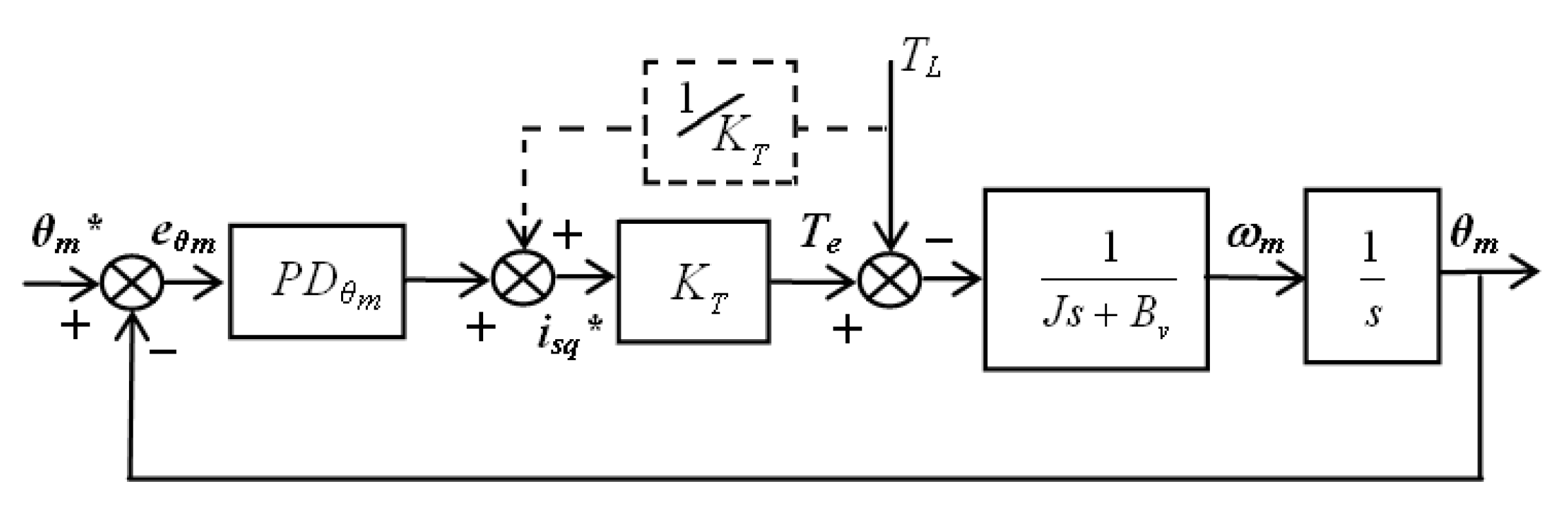


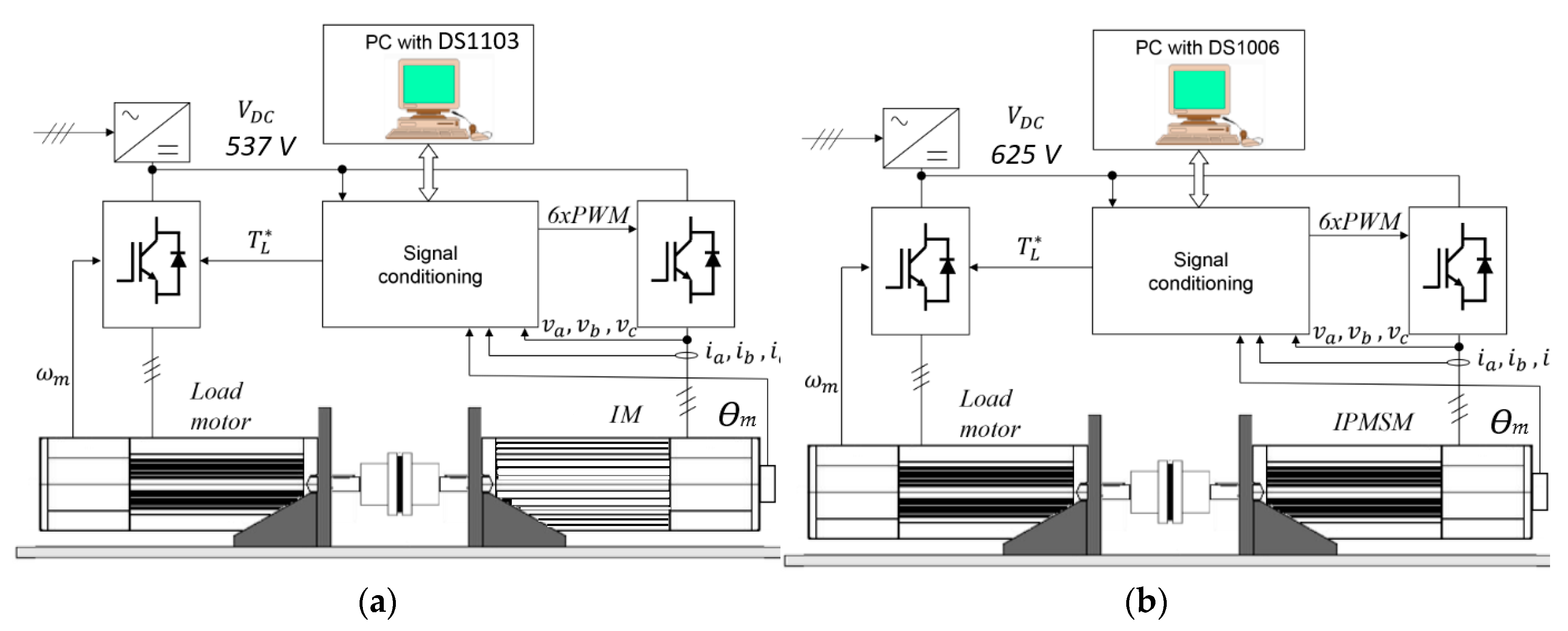
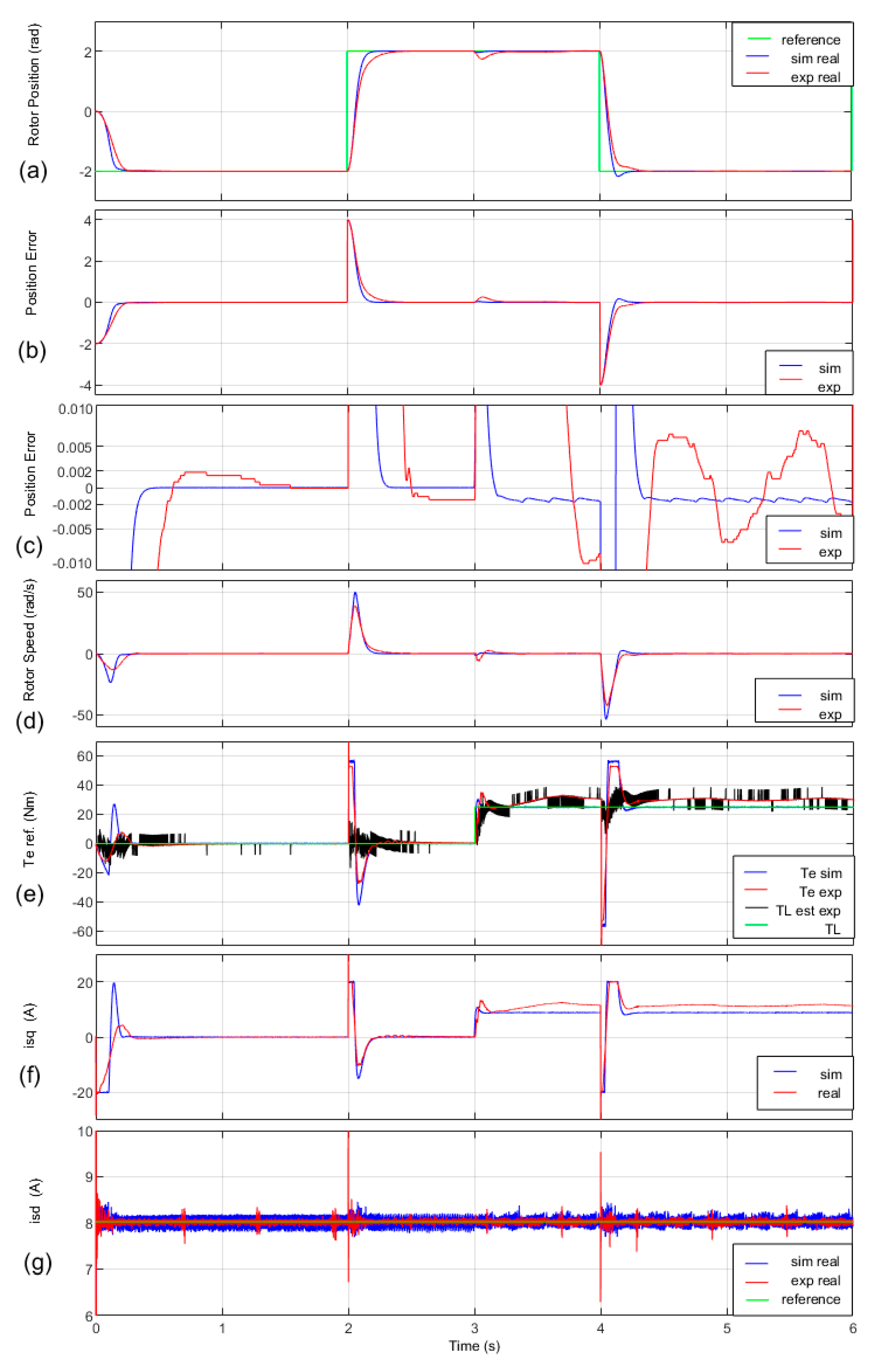
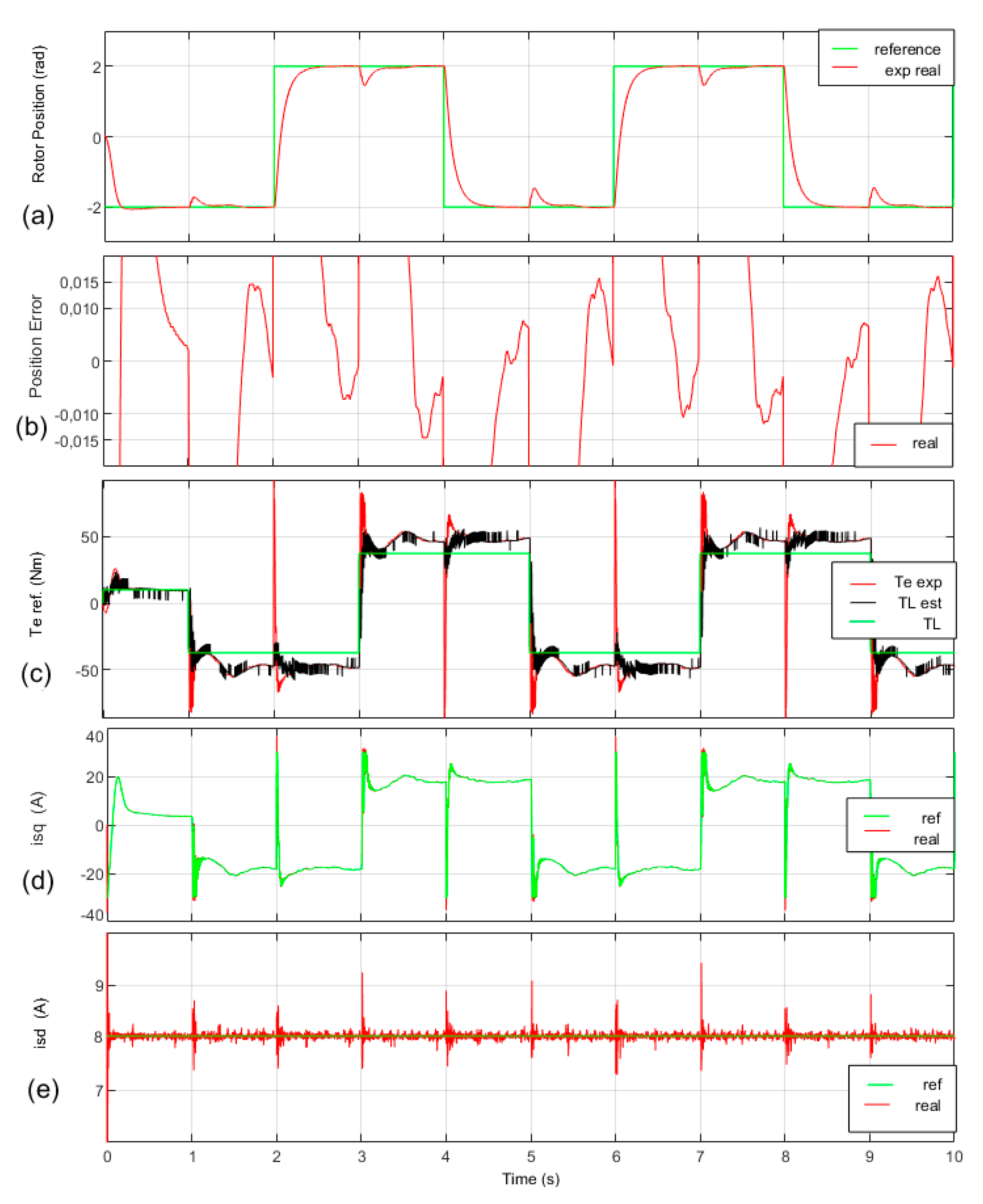

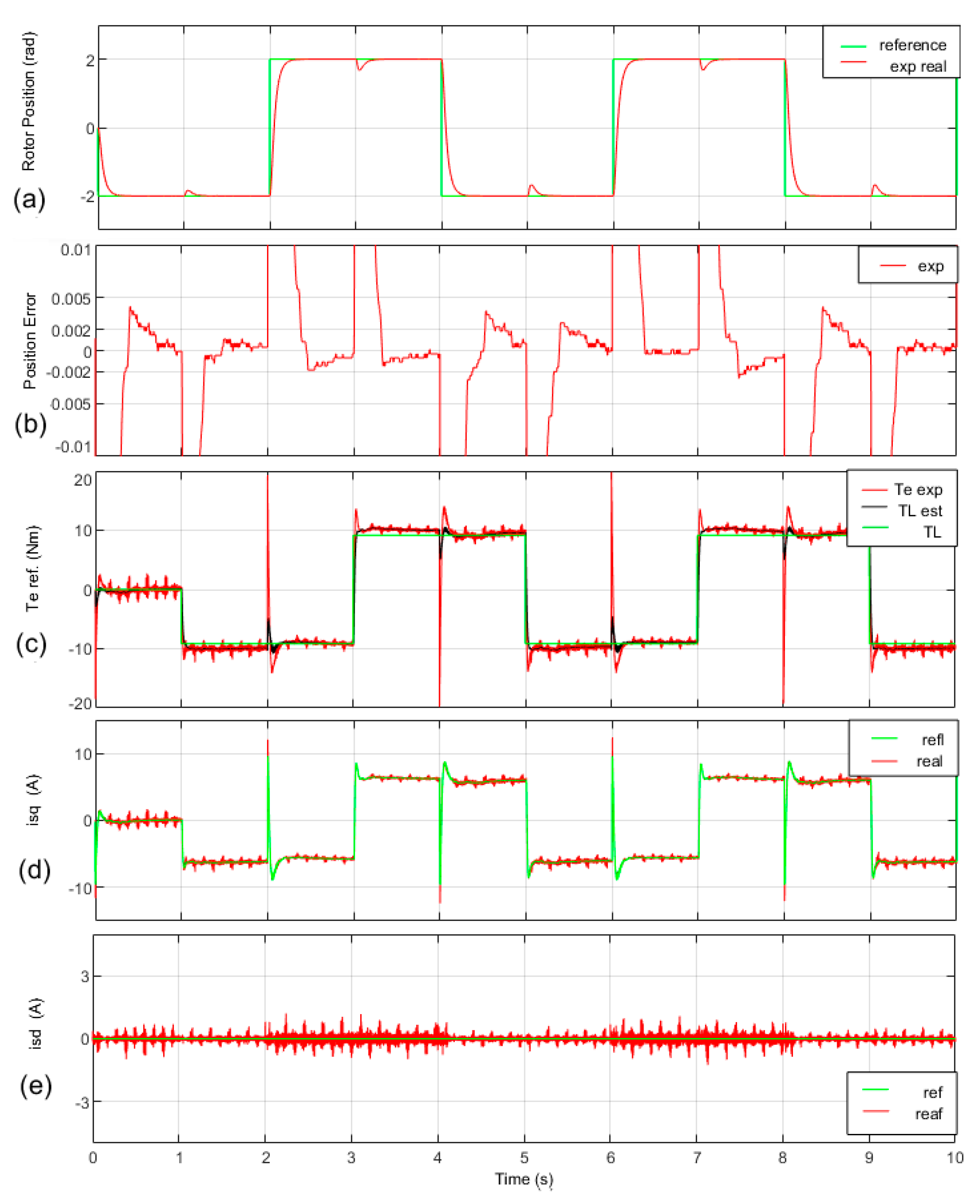
| Design | ωGCϴm | PMϴm | ωGCi | PMi |
|---|---|---|---|---|
| D1 | 50 rad/s Kpϴm = 11.1, | 74° Kdϴm = 914.63, | 3000 rad/s Kpi = 10.82, | 70° Kii = 14401 |
| D2 | 85 rad/s Kpϴm = 15.23, | 79° Kdϴm = 1597, | 3000 rad/s Kpi = 10.82, | 70° Kii = 14401 |
| Design | ωGCϴm | PMϴm | ωGCi | PMi |
|---|---|---|---|---|
| D1 | 45 rad/s Kpϴm = 2.8, | 70° Kdϴm = 139.25, | 3000 rad/s Kpi = 15, | 70° Kii = 18004 |
| D2 | 75 rad/s Kpϴm = 4.25, | 75° Kdϴm = 248.15, | 3000 rad/s Kpi = 15, | 70° Kii = 18004 |
© 2020 by the authors. Licensee MDPI, Basel, Switzerland. This article is an open access article distributed under the terms and conditions of the Creative Commons Attribution (CC BY) license (http://creativecommons.org/licenses/by/4.0/).
Share and Cite
Alkorta, P.; Barambones, O.; Cortajarena, J.A.; Martija, I.; Maseda, F.J. Effective Position Control for a Three-Phase Motor. Electronics 2020, 9, 241. https://doi.org/10.3390/electronics9020241
Alkorta P, Barambones O, Cortajarena JA, Martija I, Maseda FJ. Effective Position Control for a Three-Phase Motor. Electronics. 2020; 9(2):241. https://doi.org/10.3390/electronics9020241
Chicago/Turabian StyleAlkorta, Patxi, Oscar Barambones, José Antonio Cortajarena, Itziar Martija, and Fco. Javier Maseda. 2020. "Effective Position Control for a Three-Phase Motor" Electronics 9, no. 2: 241. https://doi.org/10.3390/electronics9020241





